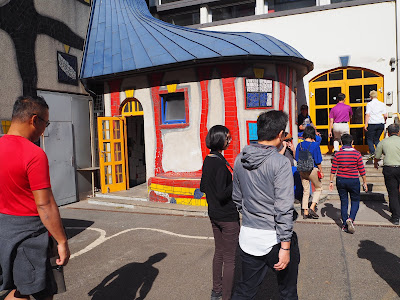Spittelau Waste Incinerator Plant in Vienna, Austria is one of the destinations of the technical tour to Eastern Europe.
The first impression of the plant is that it looks more like an amusement park for holiday makers rather than a dumpsite for rubbish disposal. Each year, it processes 0.25 million tonnes of household waste and produces 120,000 MHh of electricity, 6,000 tonnes of scrap iron and 60,000 tonnes of clinker, ash and filter cake. Heat generated is enough to heat up more than 60,000 homes.
European Union is targeting to cut down rubbish incineration by increasing recycling. By 2050, Europeans are expected to recycle 70% of urban waste and 80% of packaging waste. By 2025, EU is pushing to ban sending recyclable waste to landfill and to have 30% reduction in the amount of food thrown away.

*************************************************
Inside the Incineration Plant




 |
| Group photo at the entrance to the Incineration Plant |
*************************************************
In Ljbuljana, Slovenia, we had difficulty finding rubbish bins to discard bits and pieces of waste. Rubbish bins by the road side for local residents are all locked up and they can only be opened by the locals who have the access cards. We noticed there are four categories of bins and each for a specific type of waste - organic, residual, paper and glass. We were told that every household is allowed to deposit a certain load of waste into the bins weekly. There is clear objective to cut down solid waste and to encourage recycling.


Bins for organic waste and residual waste


Bins for paper and glass
***********************************************************
Nearer to home, I remember at one time in the late 80's, we visited the "Smokey Mountain" landfill which was a recommended itinerary of a Manila tour. Visitors were shown the massive shanty housing colonies that mushroomed around the rubbish dumpsite. At one time, 30,000 people made their living from picking trash from landfill's rubbish.
Today, shanty slums are replaced by low cost housing. Recycling is now a government policy and "scavengers" are now required to obtain permits to enter controlled dumpsites to pick trash for recycling.
Today, shanty slums are replaced by low cost housing. Recycling is now a government policy and "scavengers" are now required to obtain permits to enter controlled dumpsites to pick trash for recycling.
*************************************************
Now that we have first hand knowledge about Spittelau Waste Incinerator Plant in Vienna, the next question will be: Can Sabah have an incinerator plant of the like? This is probably too premature to consider since the mind sets of people on rubbish handling and disposal have yet to change.
 |
| Beach front in KK next to the the tower block where the Chief Minister Office in Sabah is housed! |





No comments:
Post a Comment